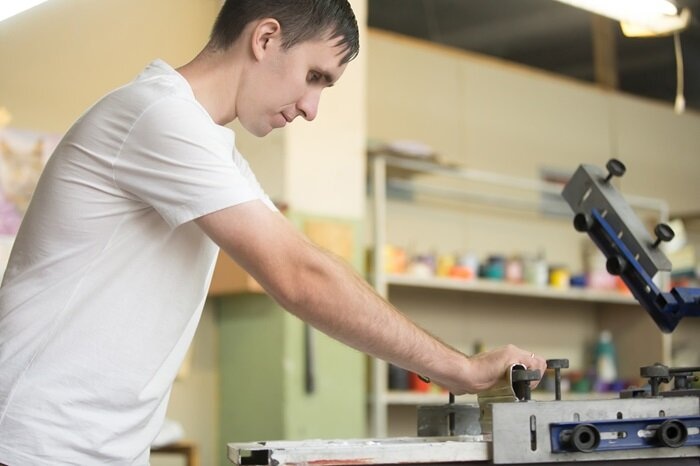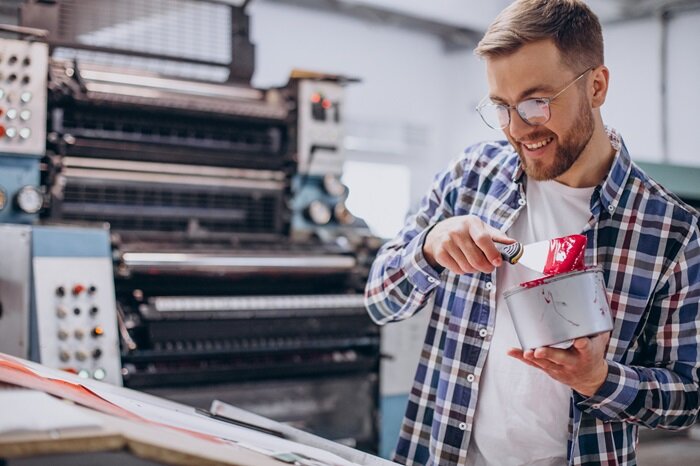When you want to get something printed, you just send it to the printer, right? Sending it to a professional is best because there are so many types of printing methods! How do you choose which printing method is the best one for your project? Keep reading below to learn the different types of printing methods and what they’re used for.
Popular Types of Printing Methods
Printing methods have come a long way since the 15th century, which is when the first printing presses were invented in Europe. From the manual labor involved in traditional printing methods to the automated processes of digital printing, the evolution has been remarkable.
Modern digital technology has dramatically transformed the printing landscape. Inkjet printing, commonly used in homes and offices, employs tiny droplets of ink to create prints. Laser printing melts toner beads onto paper using heat. Screen printing was developed to allow manufacturers to print on non-paper surfaces like coffee mugs and textiles.
Each technological advancement and demand to put a stamp on an item, from books to custom team shirts, has brought its own set of printing challenges. These different formats cater to those challenges.
Here are the main types of printing methods still used today:
Traditional Printing Methods
Traditional printing methods have a rich history that dates back centuries. These are the time-honored techniques that don’t rely on computer technology. They include letterpress, lithography, gravure, and more.
Letterpress originated in the 15th century and involves pressing inked, movable type onto paper. This method was widely used for printing books, newspapers, and other textual materials before people developed later technologies.
Lithography was invented in the late 18th century. It uses oil-based inks and a water-based resistor to transfer ink to a flat surface using a press. The reaction between oil and water keeps the ink in the right locations on the paper.
Gravure, another traditional printing method, uses engraved plates to create images with fine detail and texture. These plates are inked and pressed to paper.

Digital Printing Methods
With today’s computers and digital technology, these methods have revolutionized the printing industry. Inkjet, laser, and thermal printing are some examples.
Digital printing methods have completely changed how the printing industry works. Through digital imagery, printers can print anything their minds can imagine. Printing has also been brought to the masses through home inkjet printers and laser printers.
Inkjet printers use tiny droplets of ink to create images on paper. It offers high-quality prints with vibrant colors. Laser printing employs a laser beam to transfer toner onto paper, resulting in sharp and precise prints.
Many stores use a technique called thermal printing. This uses heat to create images on heat-sensitive paper, making it suitable for applications such as receipts and labels.
Screen Printing
Screen printing is great when you want to print on something that isn’t paper. Screen printing, also known as silk screen printing, is used for apparel printing, large posters, and signage. This method of printing involves transferring ink through a stenciled mesh screen to create the desired image or text.
Flexography
Flexography is a printing method that is specifically designed for high-volume printing on flexible materials such as paper, plastic, and foil. It involves creating a relief plate with raised images or text and then transferring ink onto the printing surface.
Flexography is perfect for printing packaging materials, labels, and tags. Its fast-drying inks make it ideal for high-speed custom printing applications.
Offset Printing
Offset printing is used for book, magazine, and newspaper printing. Print shops that do this kind of printing often specialize in it because the machines are so large. An offset printer transfers ink along many rollers to build up a full-color image on paper.
Specialized Printing Techniques
Specialized printing techniques offer unique and visually appealing effects that enhance the overall look and feel of printed materials. Various specialty printing techniques cater to specific printing needs, such as embossing, debossing, foil stamping, and more.
Embossing, for example, involves creating raised designs or patterns on paper or cardstock by pressing it between two dies. Debossing creates depressed or sunken designs. Foil stamping adds metallic or holographic foil to printed materials, creating a luxurious and eye-catching effect.
Printers often use these specialized techniques for business cards, invitations, and packaging to add a touch of elegance and sophistication.

Large Format Printing
Large-format printing involves printing on large-scale materials such as vinyl, fabric, or paper to produce oversized prints typically used for billboards, banners, and trade show displays. This method uses inkjet printers or plotters to produce high-resolution prints on materials such as vinyl, fabric, and paper.
Large-format printing allows businesses to communicate messages on a grand scale. These prints are usually done by specialist printers who have machines capable of producing large prints on a single surface. The reprographics industry, which prints blueprints of buildings for contractors, is a primary user of large-format printing.
3D Printing
3D printing is the latest technology to come onto the market for prints. Instead of printing on a flat surface, 3D printing builds three-dimensional shapes out of thin layers of plastic or resin. It has uses beyond communicating information, like other print methods.
Nevertheless, 3D printing could create promotional items that a specialty printer would normally do. If you want a unique piece of promotional material to give to someone, 3D printing is the way to go!
Choosing the Right Printing Method
Selecting the right printing method for your needs is crucial for achieving the desired results. You’ll need to consider factors such as print volume, image quality, substrate compatibility, turnaround time, and budget.
If you want to print on a t-shirt, you’ll need to use screen printing because it’s compatible with that substrate. Printing on cardboard works great with flexography. Banners and billboards require special large-format printers.
Even traditional printing methods have their place. For example, wedding invitations may use letterpress for an extremely traditional look that can’t be replicated any other way. Different types of events may demand certain kinds of printing.
Consult with printing professionals who can guide you based on your specific requirements. By working with an expert, you’ll ensure you choose the right printing method for your needs. There’s a lot more that goes into a good print than you may know!
Conclusion
In this complete guide to printing methods, we have explored various printing techniques, their evolution, and factors to consider when choosing the right method. Whether you opt for traditional printing methods, digital techniques, or specialized applications, understanding the strengths and limitations of each method will empower you to make informed decisions for your next print job.
Table of Contents
table
Recent Blogs

A Guide to Onboarding New Employees

The Best Ideas for Work Anniversary Gifts

Let’s Socialize
Never Miss a Thing
Subscribe to our newsletter and stay updated to our offers and deals!